|
Technical principle
The Flowviewer/CureLan FM series used an optimized system and the network card with auto-bypass feature. The optimized system contained the abnormal detection feature which with our anomalous traffic detecting algorithm and the driver that can collect the packets rapidly. It can collect and deal with the packets rapidly via multi-thread processing. With the concept of multicore processing, it would increase the processing speed. The Flowviewer/CureLan FM series can block the abnormal traffic on itself or used the ACL (Access Control List) commands to block the abnormal traffic. Now, the Flowviewer/CureLan FM series can support the core-switch of Alcatel, Cisco, Foundtry and Extreme. When IPS (Intrusion Prevention System) equipment faced the resource-draining attack or bandwidth-consuming attack, it might have the hardware failure problem. Due to the hardware and software were integrated well, the Flowviewer/CureLan FM series would not have this problem. 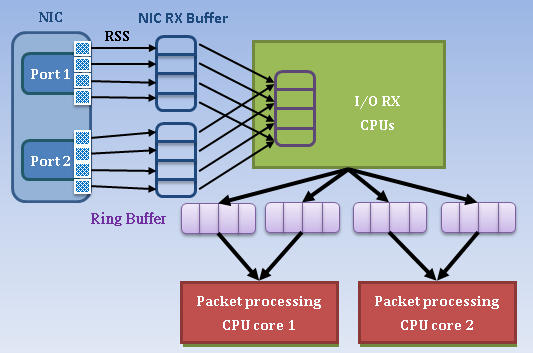
|
|
Figure 1 Using multi-cure and multi-thread to improve the effect of packet processing
|
|
Compared the technology of the Flowviewer/CureLan FM series with IPS (Intrusion Prevention System)
The IPS equipment is using the technology of deep packet inspection to filter or compare the packet that through itself with the signature. It also uses the function of threshold to distinguish cyber-attack from the traffic. This technology must contain the principle of session. It also uses the function of threshold to distinguish cyber-attack from the traffic. It needs to calculate how many packets and session will through itself. The number of threshold is setting by the user. That technology also contains the principle of session.
This technology of using session has a weakness. When it faces the DDoS attack, the amount of sessions will cause the performance of CPU goes down. Finally, it will cause the system crashed. Although the company of IPS claimed that they used ASIC chips to prevent this difficult situation. ASIC is just a general term for a microchip. CPUs are technically ASICs, but much simpler devices can be implemented on an ASIC too. You can use the IPS products and software to simulate the DDoS attack if you don't believe it. That DDoS attack would generate a lot of flows/packets to attack the device. You can observe the proportion of the rate of CPU-usage to the number of flow/packet. The X-axis is the number of flow/packet and the y-axis is the usage of CPU-usage. We used the data to plot a graph and found the usage of CPU-usage is linear relation with the number of flow/packet. If we used the more data to plot the graph, the result is approximately linear dependency. On the base of the two degrees of space, we can use the time as the z-axis to find out when will the device crash.
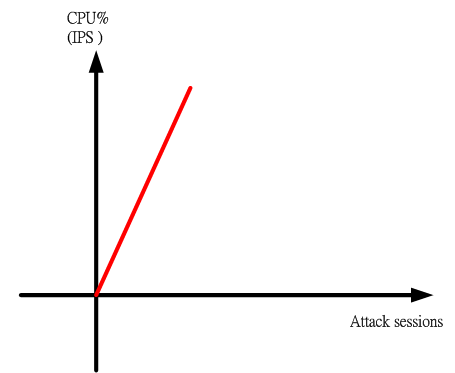
|
|
Figure 2 The schematic diagram of the number of session and CPU utilization
|
|
Why can the Flowviewer/CureLan FM series use the architecture of non-session? The Flowviewer/CureLan FM series can receive the Netflow or sFlow with sampling rate 1:1 so that it can use the architecture of non-session. The Flowviewer/CureLan FM series can find out the anomalous traffic by analyzing the data of the source IP address, the destination IP address, the time duration, the transport protocol and port number, the number of session/flow, the number of packet and traffic. Just like the theory of Big Data, the Flowviewer/CureLan FM series can analyze those huge data to find out the regularity and then determine it is attack or not. It can accurately detect the cyber-attack and intrusion by the full sampling-and-analysis processing. You can find some relative papers from IEEE journals. On the basis of the above reasons, we will suggest our customers to redirect the Netflow with sample rate 1:1 to the Flowviewer/CureLan FM series. The Flowviewer/CureLan FM series can use this data to find out the malicious traffic. The full sampling-and-analysis is the best solution. However, not every device can receive the huge data in the real world. That is another problem that you should consider. This is the reason why this technology cannot be applied to the products on the market. The Flowviewer/CureLan FM series used the mathematical formula and algorithm that developed by the Curelan Technology Co., Ltd. to analyze data. By our experience, the product of brand A can only receive the Netflow with sample rate 1:1000. In other words, it would choose 1000 packets from one million packets to be analyzed. How can this device accurately detect the attack/intrusion? That means the cyber security companies agree to this idea, but they cannot find the solution to this bottleneck of that technology.
The Flowviewer/CureLan FM series has a feature that can restrict the unauthorized accessing specific domains. All you have to do is entering the domain name and then save it. This feature just needs to analyze one packet to know the domain name. Unlike the deep packet inspection technology, it is possible to use the non-session technology.
The IPS equipment that used sessions to block the abnormal traffic would use deep packet inspection technology to analyze the packets that through it. That means the hardware failure problem would happen when it faced the huge packets. The hardware performance would be consumed by these packets. As the result of this issue, it would cause the hardware failure. The Flowviewer/CureLan FM series uses the non-session technology to prevent that problem.
|
|
Real case
A hacking group declared a DDoS attack which hit the campus network of a private university in New Taipei, Taiwan. The TV programs in Taiwan and the network news reported this event at the time. The hackers announced that they would launch another attack for another day. This university is one of our clients. The network administrator complained to us about the campus network paralysis. He could not understand why the DDoS attack would be succeeded. There is an edge router at the boundary of their network. The IPS device is downstream of the edge router; the IPS device is upstream of the Flowviewer/CureLan FM series; the core switch is downstream of the Flowviewer/CureLan FM series. Because the Flowviewer/CureLan FM series could receive the Netflow which was transferred from the core switch, that meant the core switch was not failed when the campus network was paralyzed. You can see the internal communication IP data had been recorded in the Flowviewer/CureLan FM series but you cannot find any IP data from external network to internal network or data from internal network to external network. That means the Flowviewer/CureLan FM series was not failed at that time. From the above mentioned, we can know the sticking point of network paralysis is the router or the IPS device. We would rather believe that the router is not so vulnerable. We advised using another Flowviewer/CureLan FM series to replace the IPS device. The Flowviewer/CureLan FM series had succeeded in blocking the attacking IP address at the second time. If the hackers succeeded in attacking the university, there might be another cyber-attack. The network administrator did not put the IPS device online again. You can use the huge number of sessions to attack the IPS devices. You might get a graphic like figure 2.
The IPS (Intrusion Prevention System) / IDS (Intrusion Detection System) devices are using the technology of signature to filter or compare the packet that through itself with the signature. You need to upgrade the signatures so that the device can make the most of it. This kind of device is not optimal solution when it faces the unknown attack or the zero-day attack because the hackers will change the signature of the attack every two or three days. In fact, the hackers will use the hacking tools to intrude the machines. It will guess the password of the internal devices. Once it succeeded in intruding, it will implant the Trojan horse on the device and use specific ports to do the intrusion. Some of the services will use the fixed port number so the hackers can guess the password via these port services. Some of the port services are used to do the intrusions because they are easier than others. The Trojan horse program will spread itself and then make the botnet grow bigger than before. The IPS devices use the collected signatures to compare and the packet and filter the malicious traffic. Even the user can block the outcoming attacks/intrusions, the hackers will try to steal the military/financial confidential information from inside. The most famous case is the facebook data breach. The security experts in America did not talk about the insider intrusion. They only talk about how hackers found the vulnerabilities of software. They made a conclusion about that event: It was caused by one of the employees who downloaded an APP software and then made the hacker had a change to reach the internal network. Did the user data store in the employee’s computer? Of course NOT! The hacker must use the latest Trojan horse to intrude the network and escape the detection of IPS. The equipment of IPS did not have the patterns/signatures so it is easy to escape from its detection and steal the user data. If it is not true, the Equifax data breach in 2017 will not happen again. I guess that the Sanrio, the Japanese owner of the Hello Kitty brand, was hacked and private information on 3.3 million users was exposed by the same method. You will use the similar method to steal the confidential information if you know it will be succeed. Besides, it is not difficult to hacker to create a new Trojan horse program. The corporate spy/ military spy will use the hacking program with the latest signature to do the intrusions. The device that used signature to filter or compare the packet can do nothing about this kind of attacks/intrusions. Using the technology of signature to filter or compare the packet is not bad but when it faces the amount of packets to attack or relay attack, it will cause the hardware performance goes down. We had mentioned it above. Some of IPS/IDS devices use threshold function to distinguish the cyber-attack. The low threshold value will cause the false positive problem, so the network administrator will not set a low threshold value. As the result, it gives the hackers a chance to launch the attack.
On the other hand, most of IPS/IDS devices focus on the attacks and intrusions from the external network to the internal network or from the internal network to the external network. They pay little attention to the insider intrusions or attacks. The financial and military network usually used closed network to protect themselves. The network administrator ignored the the seriousness and threatening of insider intrusion because the network had no external connectivity. When the Flowviewer/CureLan FM series analyzed the traffic from the Netflow, the insider traffic was included. Therefore, the Flowviewer/CureLan FM series can use the unique feature: inner intrusion to find out the insider intrusion.
|
|
Flowviewer/CureLan FM series used the behavior of packets to distinguish the cyber-attack and intrusion
We also created the relative equations to distinguish hacking intrusion and attack from the traffic. With the practical applications, we will modify the equations until the unit does not get the false positive results. 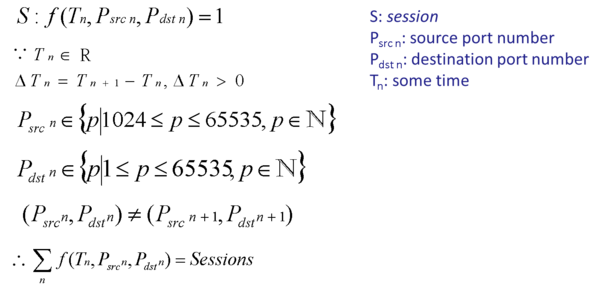
|
|
Figure 3 The Flowviewer/CureLan FM series used mathematical formula to distinguish the cyber-attack and intrusions
|
|
We have a simple explanation of the above equation. You can watch it on YouTube:
https://www.youtube.com/watch?v=yX_wp2oedYM
There is a video about "Simulate hacker attack_ Top 6 ways of hack attacks and how to protect".https://www.youtube.com/watch?v=vKweWU82okI
|
|
Real case
Case 1:WannaCry ransomware attack
The WannaCry ransomware attack was a May 2017 worldwide cyberattack by the WsnnaCry ransomware cryptoworm, which targeted computers running the Microsoft Windows operation system. It used the exploit of Windows' SMB protocol to spread itself. It can gain the access, and automatically spread itself via port 445 or port 139. Beside update the latest released patches, it was suggested that using the firewall to close the port 445. However, closing the port 445 may influence other normal services or other executed problems. After we observed some of Flowviewer/CureLan FM series, we found the number of intrusion/attack via port 445 has risen significantly. This can prove that the Flowviewer/CureLan FM series has the ability to detect and stop the attack spreading.
| A Unit | B Unit |
| Date | The number of attack/per day | Date | The number of attack/per day |
| 2017/5/1 | 6 | 2017/5/1 | 69 |
| 2017/5/2 | 14 | 2017/5/2 | 75 |
| 2017/5/3 | 19 | 2017/5/3 | 82 |
| 2017/5/4 | 24 | 2017/5/4 | 80 |
| 2017/5/5 | 29 | 2017/5/5 | 84 |
| 2017/5/6 | 25 | 2017/5/6 | 118 |
| 2017/5/7 | 20 | 2017/5/7 | 60 |
| 2017/5/8 | 15 | 2017/5/8 | 85 |
| 2017/5/9 | 18 | 2017/5/9 | 61 |
| 2017/5/10 | 18 | 2017/5/10 | 83 |
| 2017/5/11 | 18 | 2017/5/11 | 75 |
| 2017/5/12 | 309 | 2017/5/12 | 328 |
| 2017/5/13 | 286 | 2017/5/13 | 278 |
| 2017/5/14 | 94 | 2017/5/14 | 140 |
The average number of attack IP address via 445 before May 12 :19
The number of attack IP address via 445 on May 12 :309 | The average number of attack IP address via 445 before May 12 :80
The number of attack IP address via 445 on May 12 :328 |
|
|
Table 1 the number of intrusion IP addresses via 445 port in A unit and B unit from May 1 to May 14.
|
|
Even closed the port 445, the ransomware like WannaCry will use other ports to do the intrusion. Example: The Flowviewer/CureLan FM series detected the intrusion in a private university in Taiwan on November 2 2016. The intrusion was launched by the infected host from inside. It did the intrusion on a large-scale via port 6892. As figure 4 and 5 shown, the Flowviewer/CureLan FM series detected that intrusion. From this experience, we can know that it is ineffective in stopping the intrusions and attacks by controlling the specific port number. 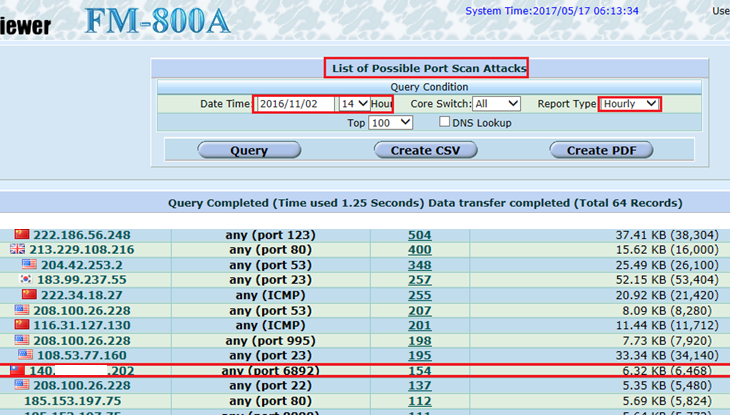
|
|
Figure 4 The Flowviewer/CureLan FM series detected the infected host in the inside
|
|
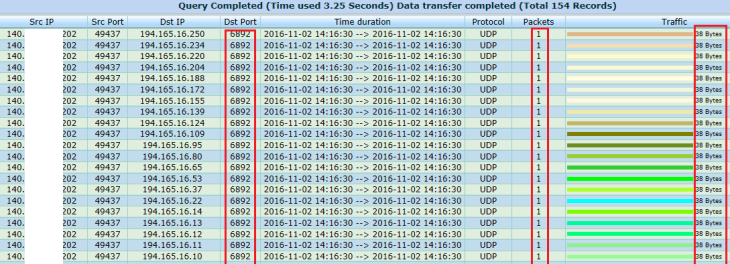
|
|
Figure 5 The detailed report of specific IP address
|
|
The Flowviewer/CureLan FM series has the ability to detect and block the intrusions and attacks. In addition, it can provide the relative report. The figure 6 and 7 showed the detailed report of port scan for a specific IP address (190.39.47.233). 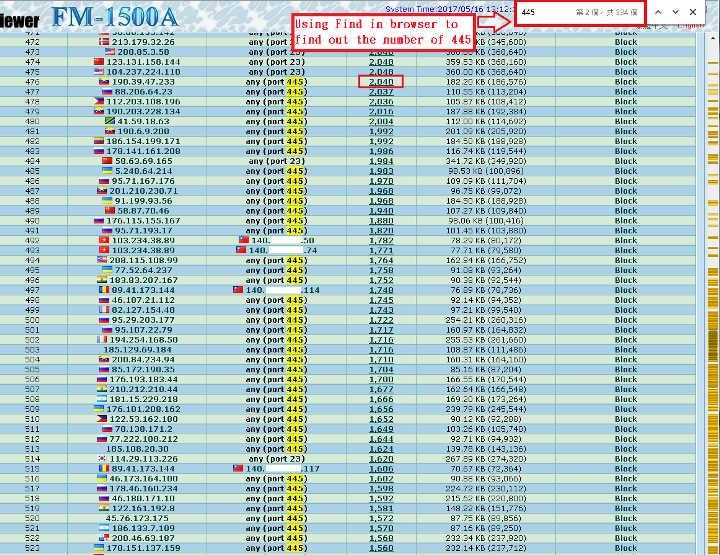
|
|
Figure 6 The portscan report on the 12 May 2018
|
|
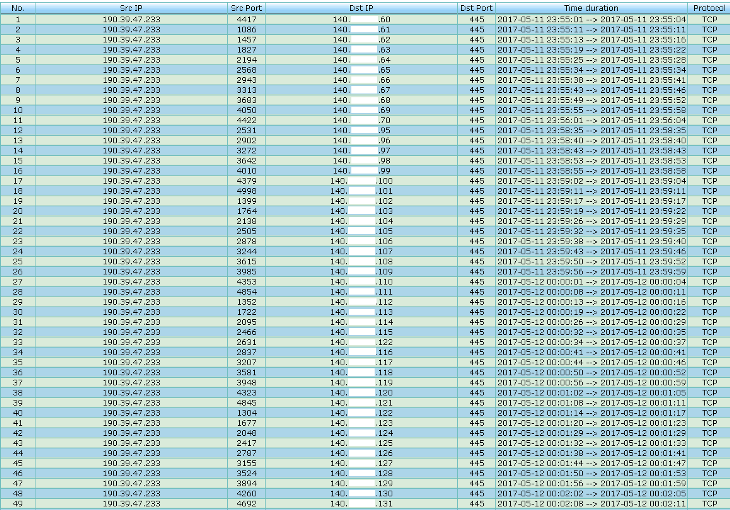
|
|
Figure 7 The detailed report of specific IP address (190.39.47.233)
|
|
Case 2:Memcached amplification attack In February 2018, an American content delivery network (CDN) and cloud services provider announced the memcached amplification attack via UDP port 11211. The amplification factor is over 50000. The GitHub, which commonly used to host open-source software projects, is one of the victims. It had suffered roughly 1.35 Tbps, more than twice the size of the September 2016. It was the biggest record since 2016. When you face this kind of attack, the defense methods such as Flow Cleaning cannot solve the physical bandwidth congestion problem. The most effective solution is blocking the anomalous traffic from upstream ISP or the Network Regional Center. We posted this idea in a security magazine: SECURITY in September 2017. I think it would be better if we can block it before the traffic was amplified. As the following figure shown, role A acts as the attackers, role B acts as the exposed memcached servers, and role C acts the victims. Is it possible to find a solution to block the anomalous traffic between A and B. The answer is pretty clearly yes. When we checked one of our Flowviewer/CureLan FM series, we found that the algorithm is still valid. It can be used to detect the abnormal traffic which is not amplified. From the report of Flowviewer/CureLan FM series, you can know that the amplification factor would not more than 50000 in the first 5 minutes.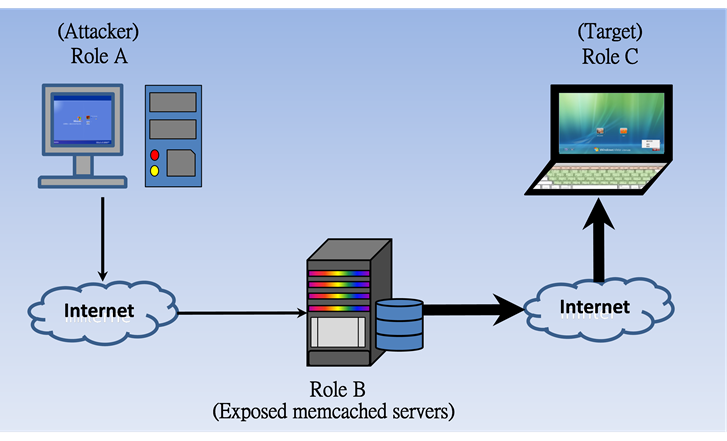
|
|
Figure 8 The schematic diagram of the memcached servers deliver amplified DDoS attack
|
|
As figure 9 shown, the Flowviewer/CureLan FM series can detect and block that abnormal traffic. You can click the number of flows to zoom in and check the detailed information. As the figure10 shown, the behavior of attack was regularly. 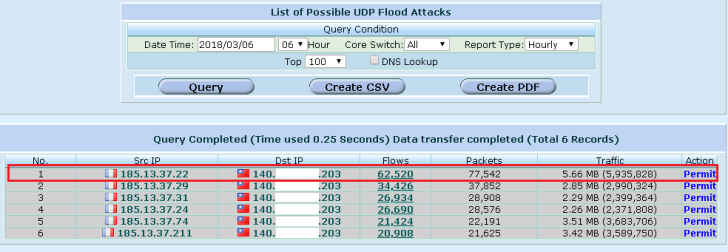
|
|
Figure 9 The attacker delivered a number of packets that contained small network traffic to the memcached server 
|
|
Figure 10 You can find out the regularity from the detailed report
|
|
Conclusion
As mentioned above, the advantages and benefits of Flowviewer/CureLan FM series included:
- The flexible deployment: the Flowviewer/CureLan FM series provides four kinds of deployment architecture for network administrator. According to the network administrator’s needs, the Flowviewer/CureLan FM series can be deployed rapidly in their network. The Flowviewer/CureLan FM series has the user-friendly user interface. It is easy to learn how to use the Flowviewer/CureLan FM series.
- The Flowviewer/CureLan FM series can collaborate with other network security devices. The network administrator can choose to block the abnormal traffic on the Flowviewer or send ACL commands to core switch to block the malicious traffic.
- The Flowviewer/CureLan FM series can use the behavior of packets to distinguish the cyber-attack and intrusion. The Flowviewer can find out the anomalous traffic by analyzing the data of the source IP address, the destination IP address, the time duration, the transport protocol and port number, the number of session/flow, the number of packet and traffic in 5 minutes. It can accurately detect the cyber-attack and intrusion by this method. You don't have to pay any extra fees for the signature updating.
- The Flowviewer/CureLan FM series can provide many reports as the cyber-crime evidence. It also provides the dynamic select feature to the administrator so that they can retrieve the data for specific conditions.
|
|

|
|
|
|
|